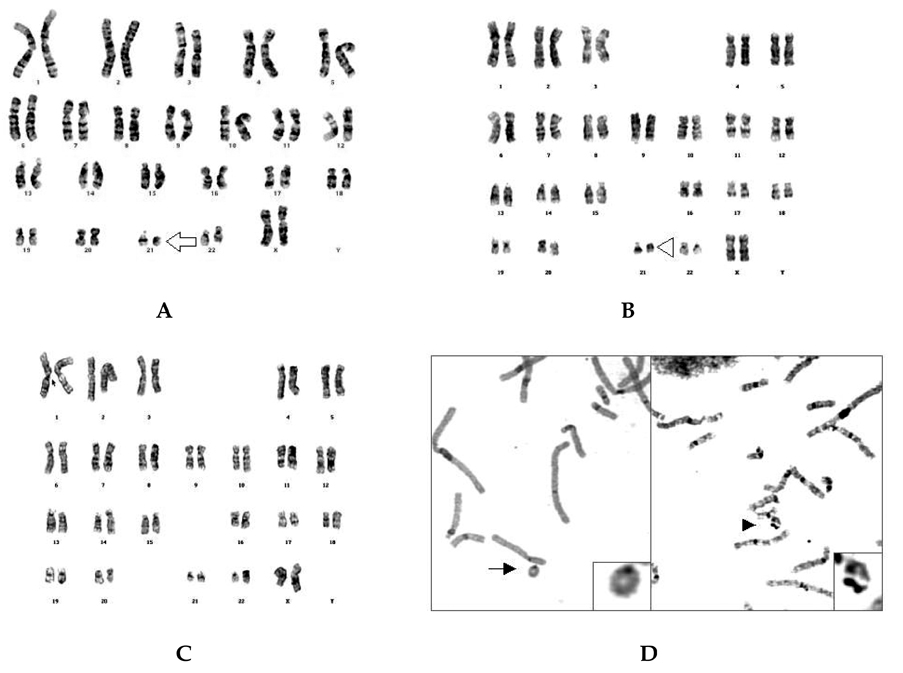Yonsei Med J.
2005 Apr;46(2):284-288. 10.3349/ymj.2005.46.2.284.
Concurrence of Ring 21 and Trisomy 21 in Children of Normal Parents
- Affiliations
-
- 1Department of Laboratory Medicine, Chonbuk National University Medical School and Research Institute of Clinical Medicine, Chonbuk National University, Jeonju, Korea. choisi11@hanmail.net
- 2Department of Psychiatry, Chonbuk National University Medical School, Chonbuk National University, Jeonju, Korea.
- 3Department of Internal Medicine, Seoul National University Medical School, Seoul National University, Jongno-gu, Seoul, Korea.
- KMID: 1734056
- DOI: http://doi.org/10.3349/ymj.2005.46.2.284
Abstract
- We present a case of two siblings with different chromosome 21 abnormalities that are both de novo [r (21) /i (21p13) mosaicism and rob (14; 21) ]. Molecular studies using polymorphic markers have shown that these two aberrations had a common maternal origin. However, the parents were cytogenetically and phenotypically normal. This unusual association has not been reported and is considered to be a unique case that should be addressed.
Keyword
MeSH Terms
Figure
Reference
-
1. Stetten G, Sroka B, Corson VL, Boehm CD. Prenatal detection of an unstable ring 21 chromosome. Hum Genet. 1984. 68:310–313.2. de Grouchy J, Turleau C. Clinical Atlas of Human Chromosomes. 1984. 2nd ed. New York: John Wiley and Sons.3. Shaffer LG, McCaskill C, Haller V, Brown JA, Jackson-Cook CK. Further characterization of 19 cases of rea (21q21q) and delineation as isochromosomes or Robertsonian translocations in Down syndrome. Am J Med Genet. 1993. 47:1218–1222.4. Ikeuchi T, Yamamoto K, Qiao Fu, Hayakama K, Migita T, Nishikawa Y. Ring chromosome 21 transmitted from mother to daughter: Its stability in a lymphoblastoid cell line. Ann Genet. 1990. 33:32–35.5. Howell RT, McDermott A, Gardner A, Dickinson V. Down's syndrome with a recombinant tandem duplication of chromosome 21 derived from a maternal ring. J Med Genet. 1984. 21:310–314.6. Ieshima A, Ogasawara N, Yamamoto Y, Kuroki Y. A case of r(21) with stigmata of atypical Down syndrome. Hum Genet. 1982. 55:65–69.7. Schmid W, Tenconi R, Baccicheti C, Caufin D, Schinzel A. Ring chromosome 21 in phenotypically apparently normal persons: Report of two families from Switzerland and Italy. Am J Med Genet. 1983. 16:323–329.8. Falik-Borenstein TC, Pribyl TM, Pulst SM, Van Dyke DL, Weiss L, Chu ML, et al. Stable ring chromosome 21: Molecular and clinical definition of the lesion. Am J Med Genet. 1992. 42:22–28.9. McGinniss MJ, Kazazian HH Jr, Stetten G, Petersen MB, Boman H, Engel E, et al. Mechanisms of ring chromosome formation in 11 cases of human ring chromosome 21. Am J Hum Genet. 1992. 50:15–28.10. Wong C, Kazazian HH Jr, Stetten G, Earnshaw WC, Van Keuren ML, Antonarakis SE. Molecular mechanisms in the formation of a human ring chromosome 21. Proc Natl Acad Sci USA. 1989. 86:1914–1918.11. Muroya K, Yamamoto K, Fukushima Y, Ogata T. Ring chromosome 21 in a boy and a derivative chromosome 21 in the mother: implication for ring chromosome formation. Am J Med Genet. 2002. 110:332–337.12. Shaffer LG, Lupski JR. Molecular mechanisms for constitutional chromosomal rearrangements in humans. Annu Rev Genet. 2000. 34:297–329.
- Full Text Links
- Actions
-
Cited
- CITED
-
- Close
- Share
- Similar articles
-
- A Case of Transient Myeloproliferative Disorder Associated with Clonal Trisomy 21 in a Chromosomally Normal Newborn
- A Cytogenetic Study of Down's Syndrome
- Prenatal Diagnosis of Recurrent Trisomy 18 Syndrome
- Molecular Diagnosis and Determination of the Parental Origin of Extrachromosome 21 in Korean with Down Syndrome Using DNA Haplotyping
- An unusual combination of trisomy 21 and partial trisomy 5q




